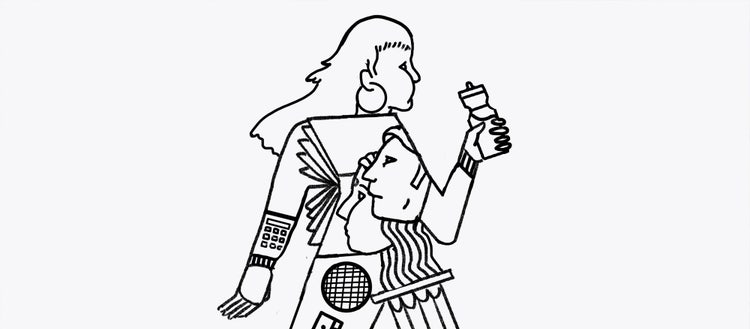For Portland-based illustrator and creative director Nishat Akhtar, art serves as a mirror for experiences and identities that she’s rarely seen portrayed before.
Born and raised in Philadelphia to Indian immigrant parents, she remembers following her older brother’s lead and gravitating to art that explored the surreal and the extraterrestrial. “Being that we were first-generation and didn’t see anyone like us, perhaps otherworldliness was an easy identification,” Akhtar says. Naturally, she was drawn to science fiction and fantasy, genres she has loved her whole life.
Embracing dualities is at the heart of Akhtar’s work featured in Adobe’s film Where I’m From, which gives a range of Asian and Pacific Islander creators the freedom to define who they are, on their own terms. Akhtar’s art brings fantastical imagery into the everyday, grounding her work in a canvas that evokes the feeling of a classic chalkboard, a fitting representation of the complexities that compose her own life.
We had the pleasure of hearing about Akhtar’s artistic evolution.
Could you tell us about your background?
While I was growing up in Philadelphia, my family took a lot of trips to India. My parents are from different backgrounds — my dad is Muslim and my mom is Hindu — and I noticed early on that was unusual in our communities. It was very controversial when my parents got married. My mom was disowned from her family. Even within Indian circles, there was something about my family that made us different.
I come from a creative family. My parents are both doctors, but my mom is super into old movies and my dad loves writing and reading. My brother works in TV, my uncle is a lyricist, and my family in India is in film. Being first-generation immigrants to the United States, my parents were very firm when they said I had to go to college. There was a lot of academic pressure, like in a lot of Asian American families, but I was a terrible student and the only kind of school I could get into was an art school. But I got into a great school, the Pratt Institute, and I studied graphic design there.
How did you get started in art?
As far back as I can remember, I’ve always been an artist. There are all these photos of me from when I was a little kid, laying on the floor, drawing at parties with a full marker set spread out around me, while adults were hanging out and chatting.
My parents have always known the fact that I loved art and nurtured me, but they have had a hard time understanding where I fit. For me, pursuing a career in the visual arts felt like venturing into the unknown. My parents never could have drawn a map to see where I would go.
When I graduated from Pratt, being purely an artist was not really an option. Graphic design was a viable career, and following that path felt like I was continuing my family’s legacy of survival. Now I’m a creative director, working with clients like Nike and Google, but the parallel road in my career has been my illustration and art practice. Illustration has functioned as a space where I’ve been able to create work that is about whatever I’m going through: feeling things, being mad, being happy, feeling confused, or making light of a hard time.
What inspires you and your creativity?
I draw to find a way to understand myself. My illustration style is magical, yet minimal, and surrealist, yet semi-sarcastic. The outside layer looks like a very simple drawing that manages to touch on all these things: pure catharsis and self-expression, the complexity of understanding the self. As a huge fan of independent comics and zines, I also bring a sense of humor to each piece. I love to see how individual artists are navigating their self-articulation in their own comics, visually, tonally, creatively and in their narrative.
I find refuge in sci-fi and fantasy. It’s a dreamy place to be. These are magical places — to believe that there’s another world where your belief can be suspended, to find a way to understand someone who has always felt misunderstood. I can impose all of this on my art.
I came of age at the intersection of American hip-hop and punk, but my Indian heritage is also important to me. I feel deeply connected to India’s beauty and its familiarity, but I’ve also struggled to see how I fit in that culture. I remember asking my mom for Indian fashion magazines as a teenager. I wanted to know what that looked like. But at the time, models and actresses in India were just one type of body, with really fair skin, a pointy nose. It wasn’t aspirational for me. The thing that I was searching for is only coming into existence today, with people like myself creating imagery that is more relatable.
I want to get closer to my ethnic identity and try to piece some things together to create an appropriate mirror to see myself. It’s hard to envision yourself in your own dream when there’s never been a pathway before.
Why is sharing your voice important?
It’s important for me to be open and honest about my struggles with depression in my art, especially since mental health is such a taboo topic in Asian American communities.
There’s healing to be found in art. You are valid and welcome and good, just by making something, period. Creativity connects me to that pure sense of childlike wonder and curiosity of this world that’s not bogged down by the obstacles of adulthood.
Getting back to that pure childhood essence of lying on the floor at a party and drawing and making your own world a place that you want to be in: That is so healing, and that is still available at any moment by just picking up a pencil.




